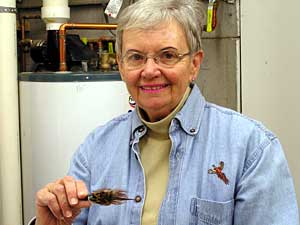|
Audio
Photos
Resources
|
 |
| Donna Landsman is known as "the feather lady." She's been making crafts with pheasant feathers for more than 50 years. Here she holds a pin made from feathers. (MPR Photo/Cara Hetland) |
Lake Benton, Minn. — Donna Landsman digs through a box stuffed with preserved pheasant pelts. She's looking for just the right color of feather.
Landsman is making a pin, gluing feathers on a tiny wood form. By the time she's finished, the pile of tiny feathers will take shape once again, as a pheasant.
Landsman layers the feathers. Tail feathers go on first, then wing feathers, and finally some white around the neck and it's finished.
"A hunter would give anything for that to be on his hat, I think," says Landsman.
Donna Landsman has been covering things with feathers for more than 50 years. She makes all kinds of crafts. Hats, jewelry, clocks and lifelike replicas of pheasants.
She first started at the request of her husband and father. They wanted the latest trend on their cowboy hats -- but it was a little spendy.
"My husband wanted a hatband. Back then they were real popular out of Miller Stockman catalog. I believe they ran from $15 to $20 a hat band," says Landsman.
So Landsman experimented. First she shot her own pheasant to get the feathers. That's when Donna and her husband lived on a farm in eastern South Dakota. She says back then the pheasants were all gold and brown, not the colorful ring-necks we're used to today.
"For me, they got boring because I only had those certain feathers to work with," says Landsman. "As they died off or were killed by predators, they started implanting pheasants. And the backs on them are green and blues. And that's what you'll see mostly today."
It gives Donna Landsman a pallet of colors any artist would dream of.
Landsman started selling her crafts, and also taught classes through the Minnesota and South Dakota extension offices. She'll never forget her first class. There were 52 students.
"I made a mistake," remembers Landsman. "I had my husband go out and shoot a pheasant because I was going to show them how to dress a pheasant properly, and two people walked out. So after that I never did dress a pheasant in a class again."
Rest assured you don't have to dress your own pheasant. Even Landsman bought her pelts from a butcher. She says the feathers last longer if they're left attached to the skin. She bought 500 pelts 15 years ago and she's still using them.
The shelves in Landsman's garage are filled with boxes of feathers. To the uninitiated, the boxes could be a little creepy. They're labeled with the pertinent body parts -- wings, tails, pelts and even heads.
Donna Landsman is slowing down now. She's 71 years old and isn't teaching much anymore.
Instead, Landsman has written an instruction book detailing 30 ways to use feathers. She published the book herself and now she's selling it at hobby shops, craft shows and over the Internet. Landsman says it's a simple art that anyone from age 7 to 107 can do.
"It's been a fun hobby, because if you want to stop you can. If you want to tear it apart you can tear it apart and start over -- you're not out anything but your time," says Landsman. "The only tools you need are a pair of scissors, a pair of tweezers, and a bottle of tacky glue and you've got it made."
Landsman says feather art is something she wants to pass down to the next generation. For her, it's like sharing a favorite recipe.







